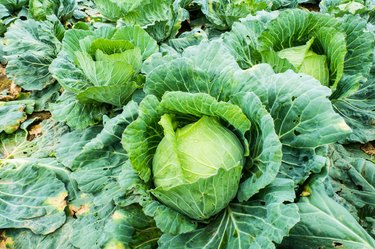
Kale and collard greens are excellent dietary sources of several essential nutrients. While not the most popular of vegetables, both provide a low-calorie source of potassium and vitamins C and K. They also offer a healthy source of dietary fiber. While you may think of milk as the primary source of calcium, both kale and collard greens can make significant contributions to your daily calcium intake.
Calcium Benefits
Video of the Day
Your bones store nearly all of the calcium in your body, with only 1 percent circulating in your bloodstream. Calcium is an important electrolyte that helps the nervous system function properly. Electrolytes are chemicals that carry an electric charge when dissolved in solution. Calcium also ensures strong bones and teeth and will help prevent osteoporosis. Adequate intake is essential. Kale and collard greens can increase your calcium intake for healthy bones.
Video of the Day
Calcium Content
A 1-cup serving of cooked kale provides nearly 10 percent of the recommended daily allowance, or RDA, of calcium for adult men and women at 94 milligrams per serving. Adults should get 1,000 milligrams each day. Collard greens exceed the RDA of kale by providing 266 milligrams in 1 cup. The effect of cooking on each of these greens is surprisingly different. A 1-cup serving of raw kale contains 90 mg, while raw collard greens have only 52 milligrams. The difference may lie in the quantity. Cooking will wilt the greens, allowing for more vegetables in a 1-cup serving. Kale may retain its shape better with cooking.
Benefits
Kale and collard greens provide a healthy alternative for getting adequate amounts of dietary calcium if you are unable to enjoy dairy products because you are lactose intolerant. Some individuals may be unable to digest the sugar, lactose, because of a lack of the necessary enzyme to metabolize it. There is no cure for lactose intolerance. If you have this condition, you can control your symptoms by getting your calcium from alternative sources, such as dark leafy greens like kale and collards, according to the Cleveland Clinic.
Cautions
While you may not think that caution is necessary for eating certain foods, both kale and collard greens can present health problems if you are taking a blood thinner such as warfarin. The reason involves their vitamin K content. While a good source of calcium, these greens are excellent sources of vitamin K. This nutrient is essential for proper blood clotting. However, individuals taking warfarin must monitor their vitamin K intake due to an increased risk of bleeding. Both contain well over the RDA of 90 micrograms for women and 120 micrograms for men. The Linus Pauling Institute recommends consuming no more than 90 to 120 micrograms of vitamin K daily, and avoiding large fluctuations in intake if you are using a blood thinner. Kale and collard greens are also high in oxalate content. Oxalates, along with calcium, are the primary minerals in kidney stones. If you are prone to stones there is a chance you may have to limit your intake of high-oxalate foods, according to the University of Wisconsin School of Public Health. In this case, speak to your doctor before adding kale and collard greens to your diet.
- Linus Pauling Institute, Oregon State University; Calcium
- USDA National Nutrient Database for Standard Reference: Kale, Cooked
- Cleveland Clinic: Lactose Intolerance
- Linus Pauling Institute, Oregon State University: Vitamin K
- Drugs.com: Warfarin
- University of Wisconsin School of Public Health: Oxalates